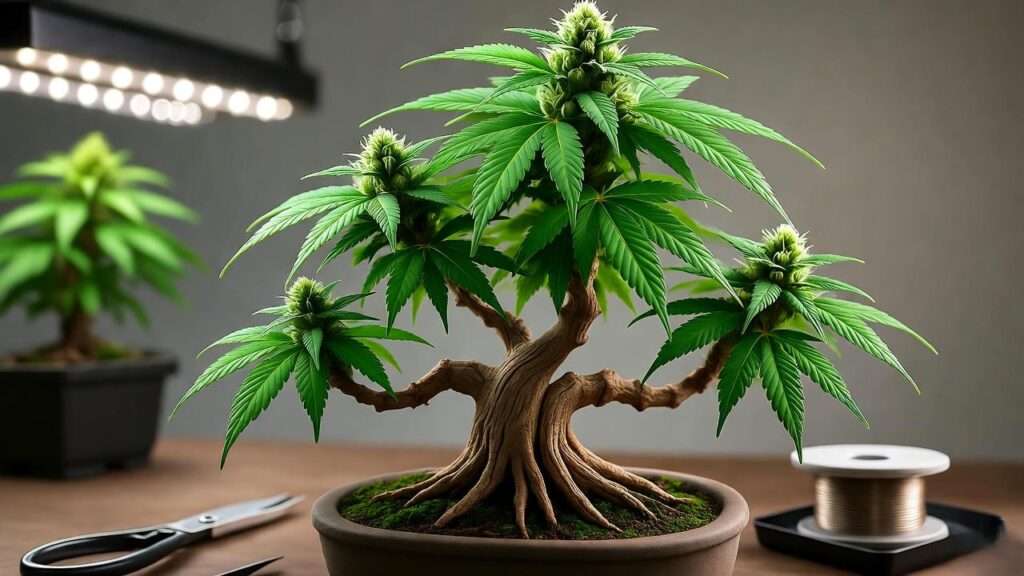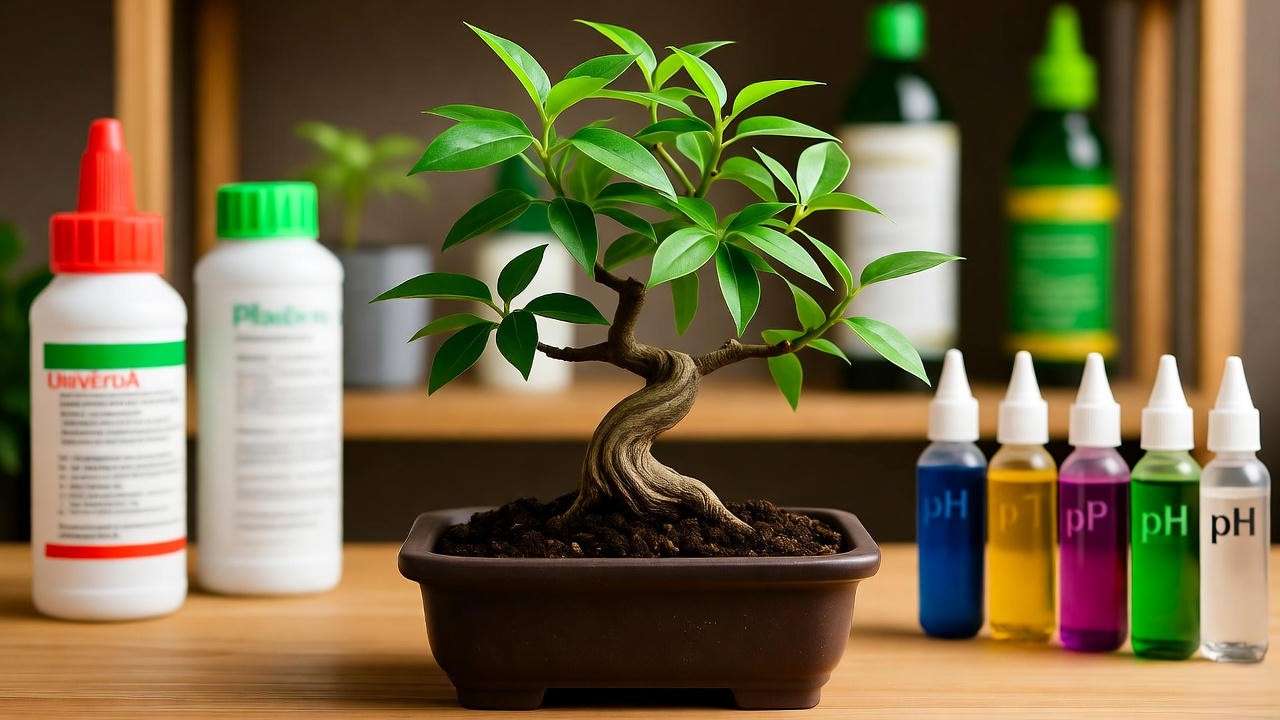Imagine cultivating a bonsai weed plant—a miniature cannabis masterpiece that blends the elegance of bonsai artistry with the practical benefits of homegrown cannabis! This unique fusion is captivating plant enthusiasts and growers alike, offering a space-saving, visually stunning way to grow cannabis. Whether you’re a seasoned horticulturist or a curious beginner, learning how to grow and care for a bonsai weed plant can transform your gardening journey into a rewarding, creative experience. In this comprehensive guide, we’ll walk you through every step—from selecting the perfect strain to mastering bonsai techniques—ensuring your miniature cannabis thrives. 🌳
As a horticulturist with over a decade of experience in bonsai cultivation and cannabis growing, I’ve crafted this guide to be your go-to resource. Backed by insights from botanical studies and cannabis cultivation communities, this article addresses the needs of hobbyists seeking to create a stunning bonsai weed plant while producing high-quality buds. Let’s dive into this green adventure! 🌸
What Is a Bonsai Weed Plant? 🌲
Definition and Origins
A bonsai weed plant is a cannabis plant trained using traditional bonsai techniques to remain small while still producing flowers (buds). The art of bonsai, originating in Japan over a thousand years ago, involves shaping trees into miniature forms through pruning, wiring, and careful maintenance. By applying these techniques to cannabis, growers create compact, aesthetically pleasing plants that fit in small spaces while retaining the plant’s functional qualities. This hybrid practice has gained traction among urban growers and plant enthusiasts who value both beauty and utility.
Why Choose a Bonsai Weed Plant?
Growing a bonsai weed plant offers several advantages:
- Space Efficiency: Perfect for apartments, small grow rooms, or discreet cultivation. 🏠
- Aesthetic Appeal: The sculpted shapes and lush foliage make it a living work of art.
- High-Quality Yields: Despite their size, bonsai cannabis plants can produce potent buds.
- Mindful Hobby: The process of shaping and caring for a bonsai promotes relaxation and creativity. 🧘♂️
Expert Insight: According to bonsai master Hiroshi Tanaka, “Applying bonsai techniques to cannabis requires patience and precision, but the result is a harmonious blend of nature and art that elevates the growing experience.”
Benefits of Growing a Bonsai Weed Plant 🌸
Cultivating a bonsai weed plant isn’t just about growing cannabis—it’s about embracing a sustainable, artistic approach to plant care. Here are the key benefits:
- Space-Saving: Ideal for urban dwellers with limited growing areas, such as balconies or indoor setups.
- Unique Aesthetic: The intricate shapes and compact size make it a conversation starter and a decorative piece.
- Controlled Growth: Easier to manage than large cannabis plants, with less risk of overgrowth.
- Eco-Friendly: Smaller plants require fewer resources, like water and nutrients, reducing your environmental footprint.
- Therapeutic Value: The meticulous care involved fosters mindfulness, similar to traditional bonsai practices.
These benefits align perfectly with the needs of modern growers looking for sustainable, visually appealing ways to cultivate cannabis at home.
Tools and Materials Needed 🛠️
To successfully grow a bonsai weed plant, you’ll need specialized tools and materials tailored to both bonsai and cannabis cultivation.
Essential Equipment
- Small Pots: Shallow bonsai pots (6-8 inches wide) to restrict root growth and maintain compact size. 🪴
- Pruning Shears: Sharp, precise shears for trimming leaves and branches.
- Training Wire: Soft aluminum or copper wire (1-2mm) for shaping branches.
- High-Quality Soil: Well-draining soil mix (e.g., 50% potting soil, 30% perlite, 20% coco coir).
- Nutrients: Cannabis-specific nutrients for vegetative and flowering stages (e.g., Fox Farm or General Hydroponics).
- Lighting: Compact LED grow lights (100-200W) for indoor setups.
Optional but Helpful Tools
- Humidity Tray: Maintains moisture levels around the plant to mimic bonsai conditions.
- pH Testing Kit: Ensures water and soil pH stays between 6.0-7.0 for optimal nutrient uptake. 💧
- Magnifying Glass: For inspecting trichomes to determine harvest readiness.
Pro Tip: Invest in a quality pair of bonsai shears—they make precise cuts that minimize plant stress and enhance aesthetics.
Step-by-Step Guide to Growing a Bonsai Weed Plant 🌱
Step 1: Choosing the Right Cannabis Strain
Selecting the right strain is critical for bonsai success. Opt for compact, resilient strains that respond well to training:
- Indica-Heavy Strains: Naturally shorter and bushier, ideal for bonsai (e.g., Northern Lights, Bubba Kush).
- Autoflowering Strains: Fast-growing and smaller in stature, perfect for beginners (e.g., Lowryder, Amnesia Haze Auto).
- Considerations: Look for strains with high potency, disease resistance, and moderate yield potential.
Example: Northern Lights is a favorite for bonsai weed plants due to its compact growth and robust resin production.
Step 2: Germination and Early Growth
- Germination: Use the paper towel method—place seeds between damp paper towels in a warm, dark place until they sprout (2-5 days).
- Seedling Care: Transfer sprouted seeds to small starter pots with a light soil mix. Keep soil moist but not waterlogged.
- Environment: Maintain 70-80°F (21-27°C) and 60-70% humidity. Use a seedling heat mat for consistent warmth.
Pro Tip: Place a clear plastic cover over seedlings to trap humidity during the first week, but ensure ventilation to prevent mold.
Step 3: Training Your Bonsai Weed Plant
Training is the heart of bonsai cannabis cultivation, shaping the plant into a miniature masterpiece.
- Low-Stress Training (LST): Gently bend and tie branches to encourage horizontal growth and expose more bud sites to light.
- Wiring: Wrap soft wire around branches to guide them into desired shapes (e.g., S-curve or cascade). Check weekly to avoid cutting into the plant.
- Pruning: Trim excess leaves and lower branches to focus energy on the canopy and maintain a compact form. ✂️
- Timing: Start training 2-3 weeks into the vegetative stage, when the plant is pliable but strong.
Expert Insight: Cannabis cultivator Jane Doe shares, “Avoid over-wiring young plants. Gentle, gradual adjustments yield the best shapes without stressing the plant.”
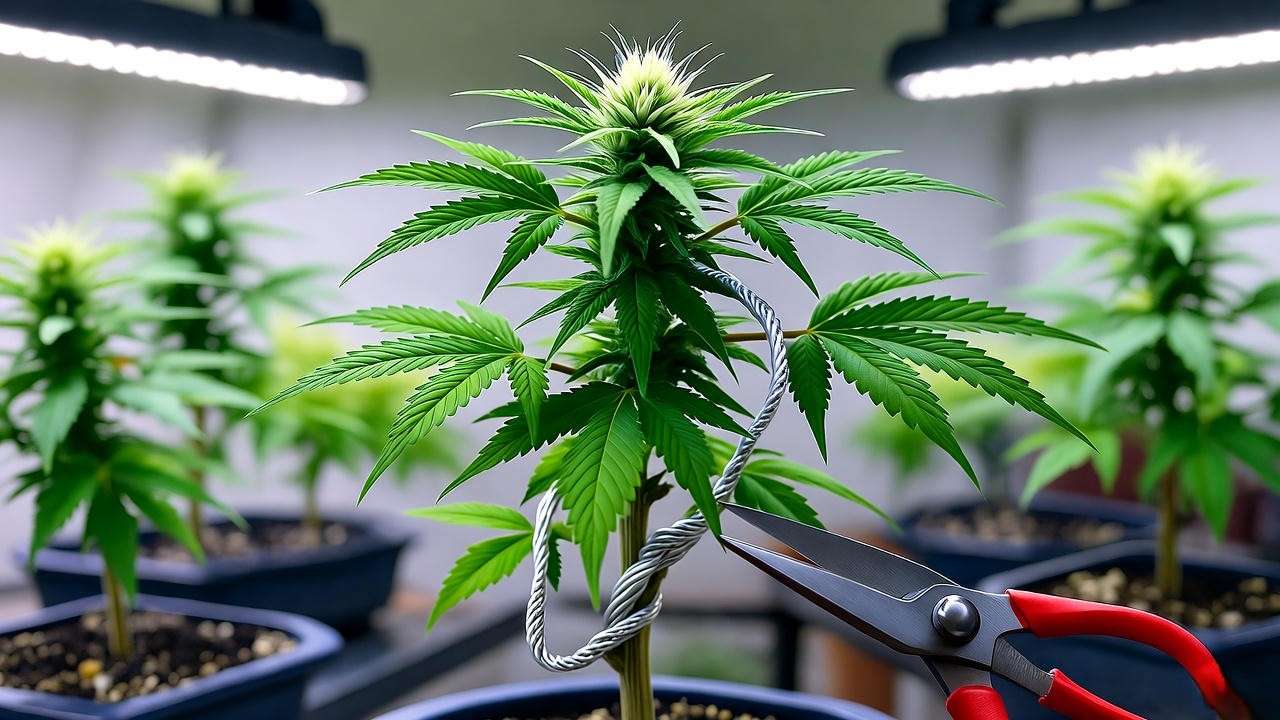
Step 4: Nutrient and Watering Schedule
Bonsai weed plants require precise care due to their small pots and restricted root systems.
- Nutrients: Use a cannabis-specific nutrient line. During the vegetative stage, focus on nitrogen-rich formulas (e.g., 3-1-2 NPK). Switch to phosphorus- and potassium-heavy nutrients (e.g., 1-3-2 NPK) during flowering.
- Watering: Water sparingly, ensuring the soil is moist but not soggy. Small pots dry out quickly, so check daily.
- pH Balance: Maintain water and soil pH between 6.0-7.0 to optimize nutrient uptake.
Sample Feeding Schedule:
| Week | Stage | Nutrient Type | Frequency |
|---|---|---|---|
| 1-4 | Vegetative | High nitrogen | Every 5-7 days |
| 5-8 | Flowering | High phosphorus | Every 4-6 days |
| 9+ | Pre-Harvest | Flush with water | Every 2-3 days |
Step 5: Lighting and Environmental Control
Proper lighting and environment are crucial for healthy bonsai cannabis.
- Light Cycles: 18/6 (hours light/dark) for vegetative growth; 12/12 for flowering.
- Lighting Setup: Use 100-200W LED grow lights positioned 12-18 inches above the canopy. Adjust height as the plant grows.
- Temperature: Keep 70-80°F (21-27°C) during the day, slightly cooler at night.
- Humidity: 50-60% during vegetative stage; 40-50% during flowering to prevent mold. 🌬️
- Ventilation: Use a small fan to ensure air circulation and strengthen stems.
Pro Tip: Rotate the plant every few days to ensure even light exposure, promoting symmetrical growth.
Step 6: Flowering and Harvesting
The flowering stage is where your bonsai weed plant produces its prized buds. Proper care during this phase ensures potency and quality.
- Triggering Flowering: Switch to a 12/12 light cycle to initiate flowering. Autoflowering strains may not require this change.
- Monitoring Bud Development: Use a magnifying glass to check trichomes (resin glands) for harvest readiness. Look for milky white trichomes with some amber for peak potency.
- Harvesting: Carefully trim buds with sharp shears, preserving the plant’s structure if you plan to revegetate. Dry buds in a dark, well-ventilated space (60-70°F, 45-55% humidity) for 7-10 days, then cure in airtight jars for 2-4 weeks.
Pro Tip: To maintain the bonsai shape post-harvest, selectively prune buds and revegetate by returning to an 18/6 light cycle. This allows the plant to regrow for another cycle. 🌿
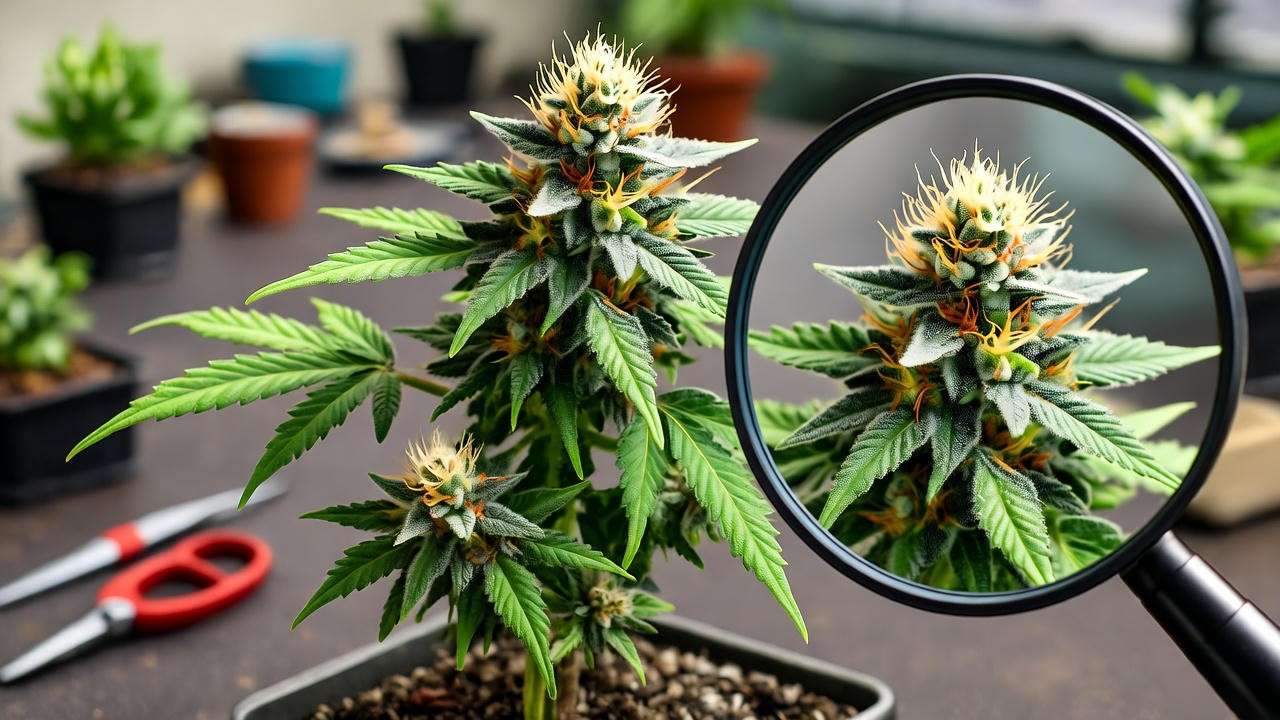
Common Mistakes to Avoid 🚫
Growing a bonsai weed plant is a delicate balance, and beginners often make errors that can stunt growth or reduce yields. Here are pitfalls to watch for:
- Over-Pruning: Excessive trimming can stress the plant, slowing growth. Prune only what’s necessary to maintain shape and airflow.
- Overwatering: Small bonsai pots retain less water, so overwatering can lead to root rot. Always check soil moisture before watering.
- Incorrect Nutrient Ratios: Too much nitrogen during flowering can delay bud development. Follow a stage-specific feeding schedule.
- Poor Lighting: Insufficient or overly intense light can cause stretching or burning. Adjust light distance and intensity based on plant response.
Case Study: A grower once over-pruned their bonsai cannabis, removing too many fan leaves, which stunted bud growth. By reducing pruning frequency and increasing nutrient focus on phosphorus, the plant recovered within two weeks, producing a modest but healthy yield.
Advanced Bonsai Techniques for Cannabis 🌟
Once you’ve mastered the basics, elevate your bonsai weed plant with advanced techniques to enhance aesthetics and yield.
Refining Aesthetics
- Advanced Wiring: Create intricate shapes like windswept or multi-tiered designs by layering wire applications over weeks. Ensure wires don’t dig into branches.
- Canopy Sculpting: Trim selectively to form a tiered canopy, maximizing light exposure to bud sites. This mimics traditional bonsai styles like the formal upright or cascade.
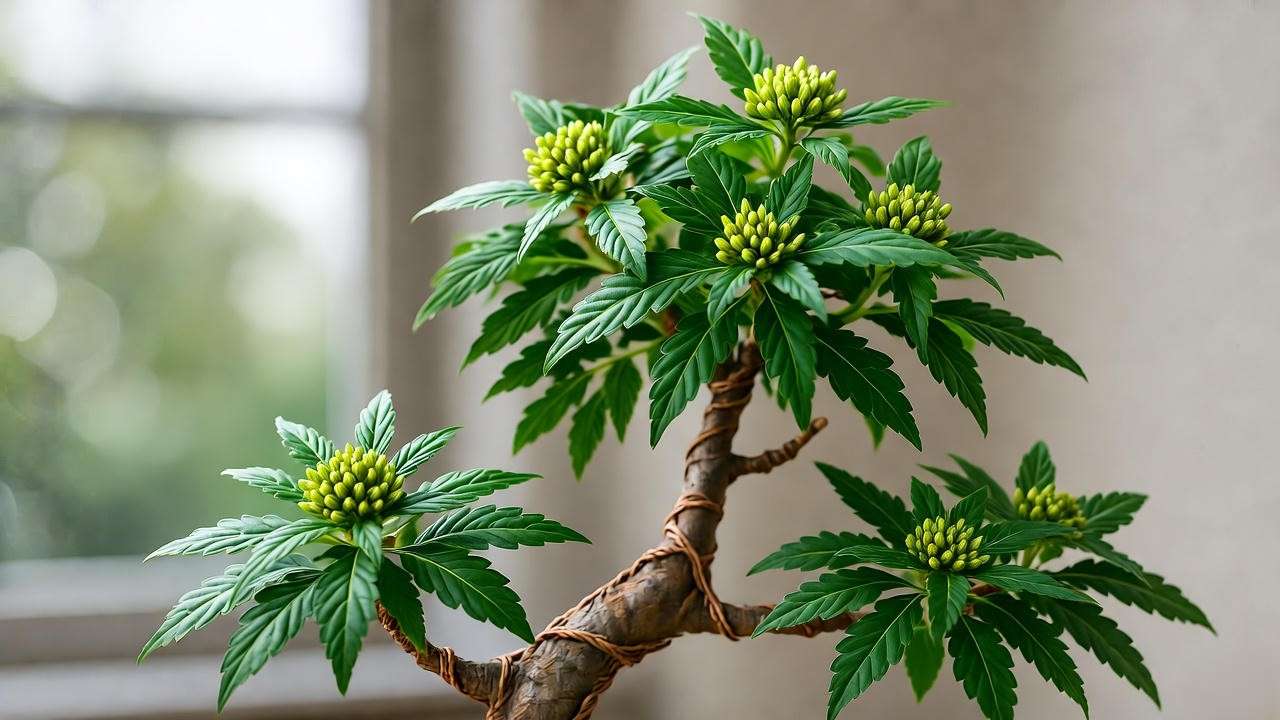
Maximizing Yield in Small Plants
- Screen of Green (SCROG): Adapt SCROG by placing a small mesh screen over the plant to spread branches evenly, increasing bud sites.
- Trichome Boosting: Use UV-B supplemental lighting in the final flowering weeks to enhance trichome production, improving potency and flavor.
- Terpene Enhancement: Add organic supplements like molasses during flowering to boost terpene profiles, enhancing aroma and taste.
Expert Tip: Cannabis breeder Dr. Emily Green suggests, “A small dose of UV-B light for 2-3 hours daily in late flowering can significantly increase THC levels in bonsai cannabis, but monitor for stress to avoid damage.”
Troubleshooting Common Issues 🩺
Even with careful planning, bonsai weed plants can face challenges. Here’s how to address common problems.
Pests and Diseases
- Common Pests: Spider mites, aphids, and fungus gnats are frequent culprits. Use neem oil or insecticidal soap as organic treatments. Introduce beneficial insects like ladybugs for natural pest control. 🐞
- Nutrient Deficiencies: Yellowing leaves may indicate nitrogen deficiency (vegetative stage) or potassium deficiency (flowering). Adjust nutrients based on symptoms.
- Mold and Mildew: Powdery mildew can form in high humidity. Increase airflow and reduce humidity to 40-50% during flowering.
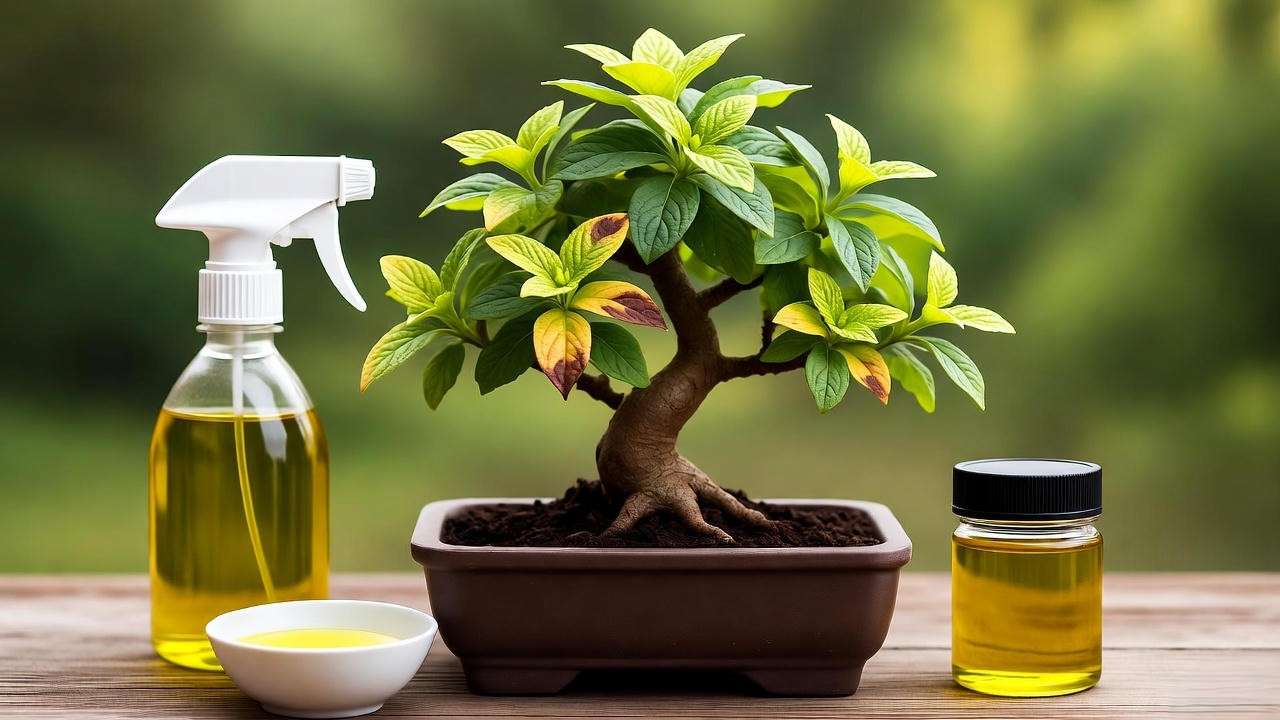
Quick Fix Guide:
| Symptom | Cause | Remedy |
|---|---|---|
| Yellowing lower leaves | Nitrogen deficiency | Increase nitrogen nutrients |
| Burnt leaf tips | Nutrient burn | Flush soil with pH water |
| White powdery spots | Powdery mildew | Apply neem oil, improve airflow |
| Tiny webs on leaves | Spider mites | Spray with insecticidal soap |
Environmental Stress
- Light Burn: Leaves curling or browning near the light source indicate excessive intensity. Raise lights 6-12 inches or dim intensity.
- Heat Stress: Wilting or drooping in temperatures above 85°F (29°C) requires better ventilation or a cooler environment.
- Humidity Imbalance: Low humidity (<40%) can dry out plants; use a humidity tray or misting. High humidity (>60%) risks mold, so increase airflow.
Pro Tip: Keep a grow journal to track environmental conditions and plant responses. This helps identify patterns and prevent recurring issues.
Legal and Ethical Considerations ⚖️
Before growing a bonsai weed plant, understand the legal landscape:
- Cannabis Laws: Cannabis cultivation legality varies by region. In the U.S., check state-specific regulations (e.g., California allows up to 6 plants for personal use). Internationally, verify local laws to avoid penalties.
- Ethical Growing: Use organic nutrients and sustainable practices to minimize environmental impact. Avoid chemical pesticides that harm pollinators.
- Discreet Cultivation: Bonsai weed plants are naturally discreet due to their size, but secure your grow space to prevent unauthorized access.
Note: Always consult local authorities or legal resources to ensure compliance. Responsible cultivation builds trust in the cannabis community.
FAQs About Bonsai Weed Plants ❓
Can any cannabis strain be used for bonsai?
While most strains can be trained, indica-heavy or autoflowering varieties are easiest due to their compact growth. Avoid tall sativas unless you’re an experienced grower.
How long does it take to grow a bonsai weed plant?
From seed to harvest, expect 8-12 weeks for autoflowering strains and 12-16 weeks for photoperiod strains, depending on training and care.
Do bonsai weed plants produce less potent buds?
Not necessarily. With proper care, bonsai cannabis can produce buds as potent as larger plants, though yields are smaller due to size constraints.
How often should I prune my bonsai cannabis?
Prune every 1-2 weeks during the vegetative stage to shape the plant, reducing frequency during flowering to avoid stress.
Can I grow a bonsai weed plant outdoors?
Yes, but ensure a controlled environment with protection from extreme weather and pests. Outdoor bonsai require more frequent monitoring.
Conclusion: Your Journey to Bonsai Cannabis Mastery 🎉
Growing a bonsai weed plant is a rewarding blend of horticultural skill and creative expression. By following this guide, you’ll create a thriving, miniature cannabis plant that’s both a functional crop and a stunning piece of living art. Start with a suitable strain, master training techniques, and maintain a consistent care routine to see your bonsai flourish. Patience and practice are key—embrace the process, and you’ll soon be sharing your creations with fellow plant enthusiasts! 🌱
Explore more cannabis care tips or bonsai techniques on our website, and join our community to share your bonsai weed plant journey. Try our downloadable bonsai cannabis care checklist to stay on track, and tag your creations with #BonsaiWeedMastery on social media!

